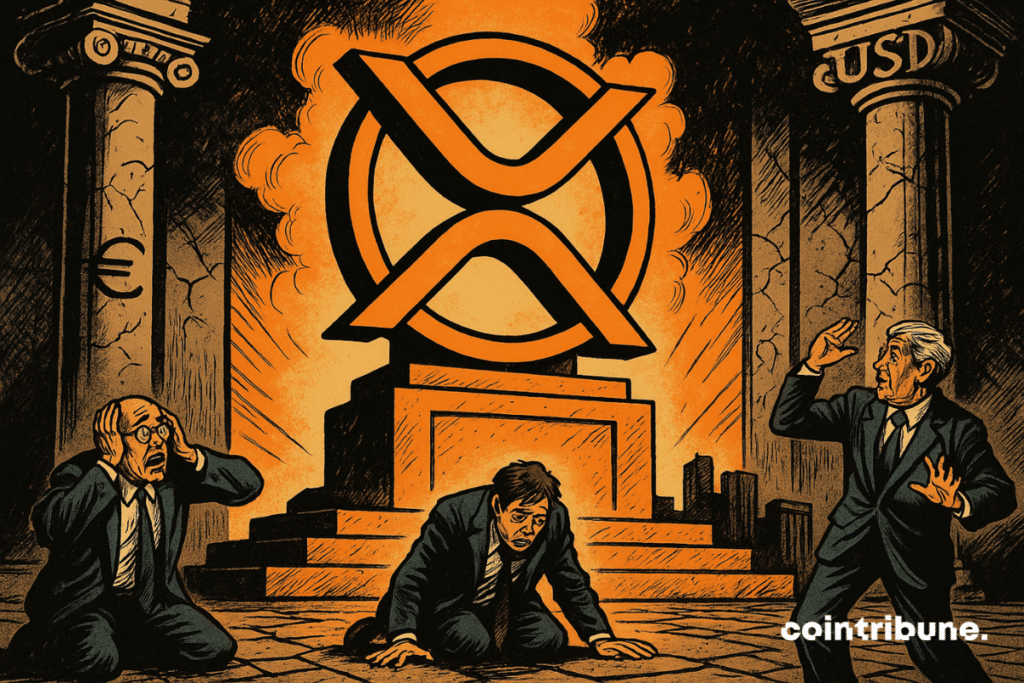🚨 XRP Tipping Point: How This Crypto Could Trigger a Global Financial Earthquake 🌍⚡
Brace for impact—XRP's next move might just rewrite the rules of global finance.
### The Domino Effect Nobody Saw Coming
Forget 'too big to fail.' XRP's brewing a storm that could leave traditional banks scrambling. Liquidity? Settlement times? The old guard's Achilles heels are Ripple's playground now.
### Why Wall Street's Watching Through Fingers
Institutional adoption isn't coming—it's already here. The same suits who mocked crypto now hedge their bets with ODL corridors. Ironic, isn't it? (Cue the 'we regulate innovation' circus.)
### The Cynic's Corner
Meanwhile, Goldman Sachs still charges $25 for wire transfers that take three days. Progress hurts, huh?

In Brief
- While Bitcoin and Ethereum dominate the scene, XRP returns to the heart of the debate on the future of the global financial system.
- Influencer Coach JV states that XRP is not aiming to coexist with banks but to replace them.
- XRP supporters highlight transaction speed (3 to 5 seconds), near-zero costs, and a network of over 300 institutions.
- Some analysts urge caution: technology alone does not guarantee adoption or massive investment.
XRP: The Champion of a New Monetary Order?
While Ripple has just submitted a banking license application, in a recent statement on the social network X (formerly Twitter), crypto influencer Coach JV reignited interest around XRP with a striking declaration: “XRP is not trying to compete with banks. It is here to replace them”.
This radical tone reflects a trend within a segment of the XRP community, convinced that Ripple and its ecosystem aim for nothing less than the substitution of traditional financial infrastructures.
XRPUSDT chart by TradingViewAccording to Coach JV, technologies implemented by Ripple already redefine the standards for global monetary transfers. He particularly emphasizes the superiority of the XRP Ledger, stating that “the old system is dead. The new financial rails are being laid before your eyes. Stay asleep and you’ll miss the greatest wealth transfer…”.
XRP is the most disruptive financial technology of our lifetime. Ripple isn’t just competing with the banking system, it’s replacing it. The old system is dead. The new financial rails are being laid right before your eyes. Stay asleep and you’ll miss the greatest wealth transfer…
— Coach, JV (@Coachjv_) July 2, 2025This vision is based on several concrete facts highlighted by XRP advocates:
- Settlement speed: transactions on the XRP Ledger execute within 3 to 5 seconds, whereas a SWIFT transfer can take up to several days;
- Nominal transaction cost: each operation costs a fraction of a cent, compared to up to 50 dollars for a traditional international transfer;
- An active infrastructure: RippleNet claims over 300 partner financial institutions in its network;
- The narrative of systemic impact: for Coach JV, XRP is “the most disruptive financial technology of our generation”.
However, at this stage, the real scope of this disruption remains limited. Indeed, despite these technical advantages, XRP’s on-chain transaction volumes plateau around one billion dollars per day, a low figure compared to the 150 billion dollars of cross-border flows processed daily worldwide.
Moreover, institutions currently experimenting with RippleNet have not yet engaged in massive transfers, limiting themselves to testing phases. This reality helps to better understand why the price of XRP remains around 2.24 dollars, without regaining the heights reached in 2018, despite renewed media coverage.
Between Regulatory Advances and Latent Adoption, a Future Still Under Construction
Another equally central but less spectacular topic lies in ongoing efforts to obtain major regulatory approvals, notably in the United States. One of the most closely watched elements at the moment is the possibility of a spot XRP ETF, whose approval could mark a turning point for the asset.
On this subject, Eric Balchunas, an analyst at Bloomberg, estimates that the chances of acceptance by the end of the year are close to 95%. Such authorization could potentially open the way for a massive influx of institutional capital, while reinforcing crypto’s legitimacy in the eyes of the general public. Meanwhile, Ripple continues to expand its scope by obtaining money transfer licenses in Europe and Asia, a strategic effort toward official recognition in several key jurisdictions.
The current user base, estimated between 1 and 2 million holders, is still limited compared to the global market. This suggests significant growth potential, according to certain community members.
Edoardo Farina, a commentator specializing in the Ripple ecosystem, specifies that this means there is still room for 100 million new users. He emphasizes that demand could strongly increase as the token becomes more widespread. However, this vision of massive adoption is conditioned by several factors, notably legal clarity, institutional trust, and technical performance in concrete use cases.
While some analysts are optimistic about XRP’s prospects, others urge measured caution. They point out that obtaining an ETF does not automatically guarantee a capital influx, just as tests conducted by banks do not necessarily imply large-scale adoption. In short, XRP remains today a bold bet, potentially transformative, but still dependent on many unknowns.
Maximize your Cointribune experience with our "Read to Earn" program! For every article you read, earn points and access exclusive rewards. Sign up now and start earning benefits.

